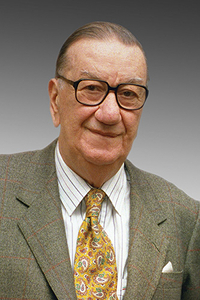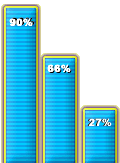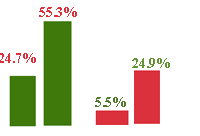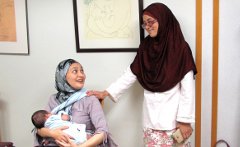 Dr. Ihsan Dogramaci, TURKEY
Dr. Ihsan Dogramaci, TURKEY
IslamSET (Islam, Science, Environment, and Technology)
http://www.islamset.com/hip/dogramaci.html
It is only recently that modern scientific research has brought to light the paramount importance of breastfeeding to the health of the child. Islam has known and emphasized this fact for some 1400 years. As one who has devoted his life to child health, this seemed a fitting topic for me to speak on at this conference.
During my training in pediatrics in the United States some 40 years ago, a number of leading pediatricians were doubting the superiority of breast milk over “more scientifically” prepared, and I am saying “more scientifically” in quotations, formula. These formulae were designed to meet the needs, sometimes very special, of the individual newborn. An example of such a special instance was the nutritional need of a prematurely born or low birthweight baby requiring more protein than a full-term baby of normal weight. As we know, the protein content in cow’s milk is three to four times higher than in human milk, and therefore in such instances formulae prepared from cow’s milk were presumed to meet the baby’s needs better.
In the United States at that time, when discharging their patients from the obstetric wards, it was routine for the doctors to prescribe a formula to be given to the baby. In the case of poor families, however, or where there was norefrigeration, breastfeeding was acceptable. The convenience for the mothers of not breasfeeding was considered an additional advantage, especially in industrialized countries where women are often used in the labor force. In the 1940s, more than three-quarters of the babies were already being bottlefed before leaving the maternity ward and when breastfeeding was instituted the duration was usually for 2-3 months. By 5-6 months of age no more than 5% of babies were still receiving mother’s milk. These figures reflect the general population, and among the better educated the incidence was far less.
The trend towards artificial feeding spread to some of the developing countries, too. As an example (figure 1 ), in the Philippines in 1950 some 90% of babies were breastfeeding, while in the year 1978 the percentage dropped to 66 among the urban poor population. In the same country in the same year, not more than 27% of the mothers in the elite brackets of society were breastfeeding their babies1.
To underestimate the benefits of breastfeeding is in contradiction to the teachings of Islam, where breastfeeding is a must for all mothers who can do so and weaning should be at about two years of age.
Yesterday at the inaugural session I quoted two verses in this connection from the Holy Quran. Now I am going to add some more.
The verse from Al-Ahqaf is interpreted as follows:
WE HAVE ENJOINED MAN TO SHOW KINDNESS TO HIS PARENTS. WITH MUCH PAIN HIS MOTHER BEARS HIM, AND WITH MUCH PAIN SHE BRINGS HIM INTO THE WORL.D. HE IS BORN AND WEANED IN THIRTY MONTHS.
The verse from El-Baqharah tells us:
MOTHERS SHALL SUCKLE THEIR CHILDREN FOR TWO WHOLE YEARS; (THAT IS) FOR THOSE WHO WISH TO COMPLETE THE SUCKLING. THE DUTY OF FEEDING AND CLOTHING NURSING MOTHERS IN A SEEMLY MANNER IS UPON THE FATHER OF THE CHILD.
The English of the Luqman verse is:
WE ENJOINED MAN TO SHOW KINDNESS TO HIS PARENTS, FOR WITH MUCH PAIN HIS MOTHER BEARS HIM AND HE IS NOT WEANED BEFORE HE IS TWO YEARS OF AGE.
The English of the Story verse is:
AND WE INSPIRED THE MOTHER OF MOSES, SAYING: SUCKLE HIM
Further, in the Hadith, the Prophet (PBUH) insisted that mothers should whenever possible breastfeed their children. According to certain witnesses, the Prophet (PBUH) even indicated, in one of his Hadiths. that those mothers who can breastfeed their babies and yet do not do so will be called to account.
Research during the past ten years has given us much new knowledge regarding the properties of human milk, properties entirely unknown earlier, and its superiority has been so well established that even in the most developed and industrialized countries mothers are again breastfeeding their babies. I would like to illustrate this trend.
In the United States, for example (figure 2), in 1971 fewer than one-quarter of mothers in the maternity wards were breastfeeding their babies during the first days of life, and at 5-6 months of age only 5.5% of babies were still receiving breast milk.. In the mid-1 970’s, when the new knowledge was made available about the unmatchable qualities of breast milk, mothers, especially in the more educated groups, started breastfeeding their babies so that by the year 1980, of the mothers in the maternity wards, more than double the number (55.3%) were found to be breastfeeding. Nearly 5 times as many mothers (24.9%) were continuing to breastfeed when their infants were 5-6 months old2.
The same trend was also observed in the Scandinavian countries. In Norway, for example (figure 3), in 1970 the incidence of mothers breastfeeding at 3 months was 22%, but this increased in the years that followed to reach some 70% in 19803. These are the published figures, and we are informed that during the last four years the increase has been continuing.
Why did this happen? It is because the most sophisticated investigations, carried out in laboratories in the West, have shown that the doubts regarding the uniqueness of breast milk, which had been prevalent for some 30-40 years in the West, were entirely unfounded. Of course, this was no news for the Islamic world.
Let me share with you some of the recent advances in our knowledge concerning the composition and functions of human milk. For many years pediatricians had been misled by the fact that in cow’s milk there is 3-4 times as much protein as there is in human milk. Of course quality is always more important than quantity but it is only very recently that research has taught us just how ideal is the quality of the relatively small percentage of protein in human milk.
TABLE 1
|
TOTAL
PROTEIN CONTENT |
|
|
Human Milk
|
Cow’s Milk
|
|
1.0%
|
3.5%
|
|
WHEN PROTEIN CONTENT(Biologically very important) |
|
|
Human Milk
|
Cow’s Milk
|
|
>70%
|
<20%
|
In table 1 we see that what is important is the whey protein content, for it is this which fosters the development of the child. There is more than 70% of it in human milk and less than 20% in cow’s milk.
It has also been discovered that the protein content of human milk is indirectly proportional to the maturity of the newborn baby. In other words, the smaller the baby, the higher the protein content of the mother’s milk5. Further, the protein content in human milk is not constant in the mother. It varies from day to day and even at different times during the same day, to suit the exact needs of the suckling.
TABLE 2
COMPARISON OF THE AMINO ACID CONTENT OF HUMAN MILK AND COW’S MILK
| Phenylalanine and tyrosine | Human milk contains less (excess may be harmful for neonates) |
| Cystine | Richer in human milk (essential for growth) |
| Methionine | Richer in cow’s milk (neonates cannot convert to cystine due to the immaturity of enzymes) |
| Taurine | 30-4-times richer in human milk than in cow’s milk (important for brain development) |
In table 2 we see that the distribution of amino acids in human milk is such as to meet the very special requirements of the human baby. Here are a few examples:
– an excess of phenylalanine and tyrosine is known to be harmful for neonates, and there are only very small amounts of these amino acids in human milk1.
– for the growth of an infant, and especially of a neonate, cystine is very important. Human milk, unlike cow’s milk, is rich in this amino acid1,6.
– normally cystine is converted from methionine. Cow’s milk contains more methionine than human milk, but neonates are unable to convert methionine into cystine due to the immaturity of the enzyme system6.
– and the last point, taurine is one of the most important of the amino acids, especially for brain development, and it is of interest to note that the taurine content of human milk is 30-40 times higher than that of cow’s milk7,8. Biochemically human milk has further advantages over cow’s milk and in the following table we see these advantages.
TABLE 3
FURTHER BIOCHEMICAL ADVANTAGES OF HUMAN MILK
– Low sodium concentration in breast milk protects the newborn against dehydration and hypernatremia.
– 50-70% of iron is absorbed from human milk compared to 10-30% from cow’s milk .
– Human milk contains a zinc-binding molecule, picolinic acid, leading to more efficient absorption of zinc from mother’s milk than from cow’s milk.
– Calcium, phosphorus ratio inbreast milk is more suitable for bone mineralization than this ration in cow’s milk.
– Cholesterol content of human milk is higher than in cow’s milk (0.16 vs. 0.110 grams per liter).
– Essential fatty acid content is higher in human milk than in cow’s milk (10.6% vs. 2.1%).
– Better absorbed 2-attached palmitic acid content is higher in human milk than in cow’s milk (74% vs. 39%).
– Presence of bile-salt dependent lipase in human milk makes fats more absorbable.
– Substantial amounts of epidermal growth factor (EGF) present in human milk.
TABLE 4
BREAST MILK CONTAINS THE FOLLOWING ANTI-INFECTIVE PROPERTIES.
– Live cells (lymphocytes, neutrophils, macrophages)
– Immunoglobulins (specifically S-lgA).
– Lactoferrin (bacteriostatic effect on E.coli, streptococcus mutants, staphylococcus aureus).
– Lysozyme (lysis of gram-psitive bacterial)
– Bifidus factor (promotes lactobacillus flora)
– Lactoperoxydase (bacteriostatic against streptococci)
– Complements (specifically C3, helps bacterial opsonization, phagocytic killing).
Besides its biochemical properties, there are certain biological factors in human milk which make it anti-infective and this explains why babies who are not breastfed are so much more prone to infectious diseases. The anti-infective properties in human milk include the following: 15-17.
– The presence of live cells, including lymphocytes, neutrophils and macrophages in human milk, contributes significantly to its anti-infective properties. The numbers of these cells are highest in colostrum and they appear to secrete lgA, lactoferrin, lysozyme and interferon. Interferon may inhibit the activity of certain viruses.
– Immunoglobulins, namely secretory immunoglobulin A (SigA), are present in large amounts in colostrum and to a lesser extent in mature human milk. SigA is resorbed only in significant amounts but has an effect against certain bacteria such as E. coli, shigella, salmonella and Vibrio cholerae. There are also SigA antibodies against certain viruses, including rota virus, which is the commonest diarrhea agent, against polio virus and against Coxsackie, enterovirus, influenza A and respiratory syncylial virus.
– Lactoferrin, a protein which binds iron to itself, is found in human milk. It has a bacterial static effect on E.coli, streptococcus mutants and staphylococcus aureus. – Lysozyme which contributes to bacterial lysis, is present in amounts several thousand times higher in human milk than in cow’s milk.
– Breast milk contains “bifidus factor” which promotes the growth of lactobacillus.
– Lactoperoxyclase in human milk acts with hydrogen peroxidase and thiocyanate ions and thus exerts a bacteriostatic effect on streplococci.
– Finally complements (and especially C3) help bacterial opsonization and phagocytic killing.
Some bottle-fed babies may gain weight faster than their breastfed counterparts. The quantity of breast milk is adjusted to the need of the growing baby, whereas formulae are given in the quantities and strengths the mother wishes, and she may give more than necessary in order to make sure her baby gains weight. This may make some parents happy, but we know now that such babies are more prone to obesity, hypertension and coronary disease in adult life 18.
The psychological factors attached to breastfeeding in contrast to artificial feeding have been well established, and therefore I am not going to expand on them.
How long should the baby be breastfed? The first six months are a must, but up to two years is very desirable in many cases as ordered in the Holy Quran and the Hadith. In this connection one of the publications of the World Health Organization, A Manual for the Treatment of Acute Diarrhoea of the Programme for the Control of Diarrhoeal Diseases (WHO/C13D/SER/80.2) states:
Exclusive breast feeding for 4-6 months – – offered as often and as freely as the infant desires it and continued breast feeding up to at least two years of age are most important in the prevention of infantile diarrhoea. Breast milk is the best food for infants and has immunological properties which help prevent infection including diarrhoea.
Jelliffe and others are among those who advocate the same two-years period whenever feasible. In short, the West, after exhaustive investigations, has come to what was ordered 1400 years ago in the Holy Quran.
REFERENCES
1. SANTOS OCAMPO P. “Country Reports: Philippines”. In Valyasevi A. Baker J. (eds.) Proceedings of Workshop on Breastfeeding and Supplementary Foods. Bangkok: Bangkok Medical Publisher, 1980, p.35.
2. MARTINEZ GA, DODD DA, SAMARTGEDES JA. “MilkFeeding Patterns in the United States during the first 12 months of fife”. Pediatrics 68:863, 1981.
3. HELSING E. “Infant Feeding in Norway, a Preliminary Overview”. Report to WHO Regional Committee 1981, Oslo, 1981, p.2.
4. HAM B RAEUS L. “Propriatary milk versus human breast milk in infant feeding”: a critical appraisal from the nutritional point of view. Pediatr. Clin. North Am. 24:17, 1977.
5. ATKINSON JA, BRYAN H, ANDERSON H. “Humanmilk feeding in premature infants”: protein, fat, and carbohydrate in the first two weeks of life. J. Pediatr. 99:617, 1981.
6. STURMAN JA GAULL G, RA1HA NCR. “Absence of cystathionase in human fetal liver”: Is cystine essential? Science 169:74, 1970.
7. GYORGY P. “Biochemical aspects of human milk”. Am. J Clin. Nutr. 24:970, 1971.
8. STURMAN JA, RASSIN DK, GAULL GE. “Taurine in developing rat brain”. Transfer of (355) taurine to pups via the milk, Pediatr. Res. 11 :28, 1977.
9. SAARINEN UM, SHMES MA, DALLMAN PR. “Iron absorption in infants”: High bioavailability of breast milk iron as indicated by the extrinsic tag method of iron absorption and by the concentration of serum ferritin. J. Pediatr. 91:36, 1977.
10. DUNCAN JR, HURLEY LS. “Intestinal absorption of zinc”: a role for a zinc-binding ligand in milk. Am. J. Physiol. 235:556, 1978.
11. GREER FR, TSNAG RC, LEVIN RS et. al. “Increasing serum calcium and magnesium concentrations in breast-fed infants”. J Pediatr 100:59, 1982.
12. FRIEDMAN G, GOLDBERG SJ. “Concurrent and subsequent serum cholesterol of breast and formula-fed infants”. Am J Clin Nutr 28:42, 1975.
13. WIDDOWSON EM, “Nutrition”. In Davis JA. Dobbing J (eds). Scientific Foundations of Pediatrics. London: Heinemann Med., 1974, p.44.
14. MORAN JR, COURTNEY ME, ORTH DN, et. al. “Epidermal growth factor in human milk”. Daily production and diurnal variation during early lactation in mothers delivering at term and at premature gestation. J. Pediatr. 103:402, 1983.
15. CHANDRA RK. “Immunological aspects of human milk”. Nutr. Rev. 36:265, 1978.
16. BROCK JH. “Lactoferrin in human milk”: Its role in iron absorption and protection against enteric infection in the newborn infant. Arch Dis Child 55:617, 1980.
17. DOWN HAM MAPS, SCOTT R, SIMS DG, et. al. “Breastfeeding protects against respiratory syncitial virus infections”. Br Mad J 2:274, 1976.
18. KRAMER MS. “Dobreast-feeding and delayed introduction of solidfoods against subsequent obesity?”. J Pediatr 98:883, 1981.
Dr. Ihsan Dogramaci, TURKEY
IslamSET (Islam, Science, Environment, and Technology)
http://www.islamset.com/hip/dogramaci.html







